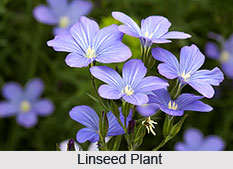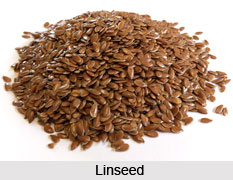 Linseed, also known as flax, is a fibre and food crop which usually grows in the cold regions of the country. Botanically it is known as Linum usitatissimum and is the member of Linum genus and Linaceae family. It is an annual plant which grows upright to a height of about 1.2 metres and has slender stems. The leaves of the plant are glaucous green and slender lanceolate in shape having 20 to 40 millimetres length and 3 millimetres breadth. Pale blue flowers of the plant having 15 to 25 millimetres diameter exhibit five petals. Some of the flowers are bright red in colour. Linseed plant has a round fruit which contains many glossy brown seeds the shape of which resembles an apple pip. Apart from having a number of medicinal uses linseed also forms an important ingredient in several wood finishing products. Linseed is also grown as an ornamental plant in gardens.
Linseed, also known as flax, is a fibre and food crop which usually grows in the cold regions of the country. Botanically it is known as Linum usitatissimum and is the member of Linum genus and Linaceae family. It is an annual plant which grows upright to a height of about 1.2 metres and has slender stems. The leaves of the plant are glaucous green and slender lanceolate in shape having 20 to 40 millimetres length and 3 millimetres breadth. Pale blue flowers of the plant having 15 to 25 millimetres diameter exhibit five petals. Some of the flowers are bright red in colour. Linseed plant has a round fruit which contains many glossy brown seeds the shape of which resembles an apple pip. Apart from having a number of medicinal uses linseed also forms an important ingredient in several wood finishing products. Linseed is also grown as an ornamental plant in gardens.
Ecology of Linseed
Linseed grows best in deep loams having large amount of organic matter and alluvial soil. Heavy clay or soils of sandy or gravely nature impairs their growth. Its farming requires some pesticides and fertilizers. The plant reaches to a height of 10 to 15 centimetres within 8 weeks of sowing. Under optimal conditions it grows several centimetres per day and reaches 70 to 80 centimetres in fifteen days.
Medicinal Uses of Linseed
 Linseed contains micronutrients in abundant amount along with omega-3 fatty acids and dietary fibres. They are helpful in lowering cholesterol level. Some studies suggest that they are beneficial for individuals having breast or prostrate cancer. It also reduces the severity of diabetes by the stabilization of blood sugar levels. Owing to its dietary fibre content, flax seeds also act as laxative. However their excessive consumption without liquid may cause intestinal blockage. Lignan is one of the prime components of linseed which contains antioxidants and plant estrogen. Linseed can also be used externally or internally for treating diseases of eyes, respiratory tract, rheumatism, gout, fever, flu, cold and infections. Linseed is mainly cultivated for its edible oil and also serves as a nutritional supplement. Over consumption of flax seeds may also cause paralysis, convulsions and breathing trouble.
Linseed contains micronutrients in abundant amount along with omega-3 fatty acids and dietary fibres. They are helpful in lowering cholesterol level. Some studies suggest that they are beneficial for individuals having breast or prostrate cancer. It also reduces the severity of diabetes by the stabilization of blood sugar levels. Owing to its dietary fibre content, flax seeds also act as laxative. However their excessive consumption without liquid may cause intestinal blockage. Lignan is one of the prime components of linseed which contains antioxidants and plant estrogen. Linseed can also be used externally or internally for treating diseases of eyes, respiratory tract, rheumatism, gout, fever, flu, cold and infections. Linseed is mainly cultivated for its edible oil and also serves as a nutritional supplement. Over consumption of flax seeds may also cause paralysis, convulsions and breathing trouble.
Linseed Fibres
Linseed Fibres or flax fibres are obtained from skin of the stem of the plants. These fibres are flexible, soft and lustrous. They are two to three times stronger than cotton fibres but have less elasticity. These fibres are also popular for being naturally straight and smooth. The fibres of the plant are also used in making linen. Linen fabrics are made with the best grade fibres whereas the coarser grades find their use in the manufacture of twine and rope. It also serves as a raw material in the high quality paper industry for making printed banknotes and tea bags.



















